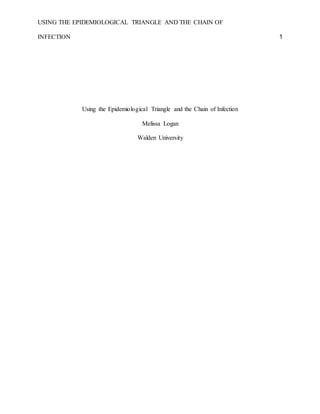Denunciar
Compartir

Recomendados
berisi tentang cara belajar reported speech dengan mudah berisi penjelasan yang ringkas serta dilengkapi dengan contoh-contoh nyata sehingga anda akan lebih mudah memahaminya dan tentu saja tanpa rumus-rumusan.Belajar reported speech dengan mudah

Belajar reported speech dengan mudahLEC BALI - Kursus Les Bahasa Inggris Private Gratis di Denpasar Bali
Más contenido relacionado
Destacado
berisi tentang cara belajar reported speech dengan mudah berisi penjelasan yang ringkas serta dilengkapi dengan contoh-contoh nyata sehingga anda akan lebih mudah memahaminya dan tentu saja tanpa rumus-rumusan.Belajar reported speech dengan mudah

Belajar reported speech dengan mudahLEC BALI - Kursus Les Bahasa Inggris Private Gratis di Denpasar Bali
Destacado (12)
Similar a Wk3Assgn1LoganM
Similar a Wk3Assgn1LoganM (20)
Describe this traditional triangle of epidemiology. What model is .docx

Describe this traditional triangle of epidemiology. What model is .docx
Microbiology and Parasitology (Chain of Infection).pptx

Microbiology and Parasitology (Chain of Infection).pptx
2. Components of Infectious disease cycle.pptx [Repaired].pptx![2. Components of Infectious disease cycle.pptx [Repaired].pptx](data:image/gif;base64,R0lGODlhAQABAIAAAAAAAP///yH5BAEAAAAALAAAAAABAAEAAAIBRAA7)
![2. Components of Infectious disease cycle.pptx [Repaired].pptx](data:image/gif;base64,R0lGODlhAQABAIAAAAAAAP///yH5BAEAAAAALAAAAAABAAEAAAIBRAA7)
2. Components of Infectious disease cycle.pptx [Repaired].pptx
Module 5 Case Assignment Pertussis (Whooping Cough)TasksPart .docx

Module 5 Case Assignment Pertussis (Whooping Cough)TasksPart .docx
1- Principles of the Infectious Diseases(1) (3).pptx

1- Principles of the Infectious Diseases(1) (3).pptx
When epidemiologists are working to track a disease, the three e.docx

When epidemiologists are working to track a disease, the three e.docx
Drug Resistance Rising Among Mycobacterium Tuberculosis...

Drug Resistance Rising Among Mycobacterium Tuberculosis...
Wagner College Forum for Undergraduate Research, Vol 10 No 2

Wagner College Forum for Undergraduate Research, Vol 10 No 2
Introduction of Communicable and Tropical Diseases

Introduction of Communicable and Tropical Diseases
Communicable diseases, routes of transmission and control

Communicable diseases, routes of transmission and control
Wk3Assgn1LoganM
- 1. USING THE EPIDEMIOLOGICAL TRIANGLE AND THE CHAIN OF INFECTION 1 Using the Epidemiological Triangle and the Chain of Infection Melissa Logan Walden University
- 2. USING THE EPIDEMIOLOGICAL TRIANGLE AND THE CHAIN OF INFECTION 2 The epidemiological triangle displays the three factors necessary to cause the transmission of an infectious disease (Songer, n.d.) The three required factors include a host, agent, and environment. In this paper I will discuss the epidemiological triangle and the chain of infection for Lyme disease. The agent in the epidemiological triangle of Lyme disease is the bacterium Borelia burgdorferi, also known as the deer tick or blacklegged tick (Centers for Disease Control [CDC], 3013). Borelia burgdorferi is a biological agent (Laureate Education, Inc., 2011). The host in this epidemiological triangle is a tick, and then a human, and the environment is warm weather in wooded areas. “Note that hunting and dressing deer or squirrels may bring you into close contact with infected ticks” (CDC, 2013, para. 8). Host factors include personal traits and behaviors, such as hiking or running in wooded or bushy areas, not covering exposed skin, or not using tick repellents on exposed skin (Songer, n.d.; CDC, 2011). The chain of infection diagram is below. The first step in the chain of infection is the existence of the pathogenic microorganism (Laureate Education, Inc., 2011). The pathogenic microorganism is known as the agent in the epidemiological triangle. Step two in the chain of infection, the reservoir, in the case of Lyme disease, is the deer tick. “The Lyme disease bacterium, Borrelia burgdorferi, is spread through the bite of infected ticks” … “In most cases, Host: Tick/Human Agent: Borrelia burgdorferi Environment: Tick-infested woods
- 3. USING THE EPIDEMIOLOGICAL TRIANGLE AND THE CHAIN OF INFECTION 3 the tick must be attached for 36-48 hours or more before the Lyme disease bacterium can be transmitted” (CDC, 2013). This explains steps three and four in the chain of infection, known as the portal of exit or means of escape and mode of transmission, respectively. The mode of transmission is indirect and vector borne through the tick bite (Laureate Education, Inc., 2011). The portal of entry into the new host, step five in the chain of infection, is the skin that has been bitten by the tick (Laureate Education, Inc., 2011; CDC, 2013). Finally, step six in the portal of entry is host susceptibility, the strength or weakness of the host’s immune system and the pathogen’s virulence (Laureate Education, Inc., 2011; Krasner, & Riegelman, 2013). #2 Reservoir#1 Pathogenic microorganism #3 Means of Escape #4 Mode of Transmission #5 Means of Entry #6 Host Susceptibility
- 4. USING THE EPIDEMIOLOGICAL TRIANGLE AND THE CHAIN OF INFECTION 4 References: Centers for Disease Control. (2013). Lyme disease transmission. Retrieved from http://www.cdc.gov/lyme/transmission/index.html Centers for Disease Control. (2011). Preventing tick bites. Retrieved from http://www.cdc.gov/lyme/prev/on_people.html Krasner, R., & Riegelman, R. (2013). Human disease and prevention (Laureate Education, Inc., custom ed.). Burlington, MA: Jones & Bartlett Learning. Laureate Education, Inc. (2011). Infectious disease process and chain of infection [PowerPoint slides]. Baltimore, MD: Author. Songer, T. (n.d.). Introduction to the fundamentals of epidemiology. University of Pittsburgh and Aga Khan University. Retrieved from www.pitt.edu/~super7/19011-20001/19061.ppt